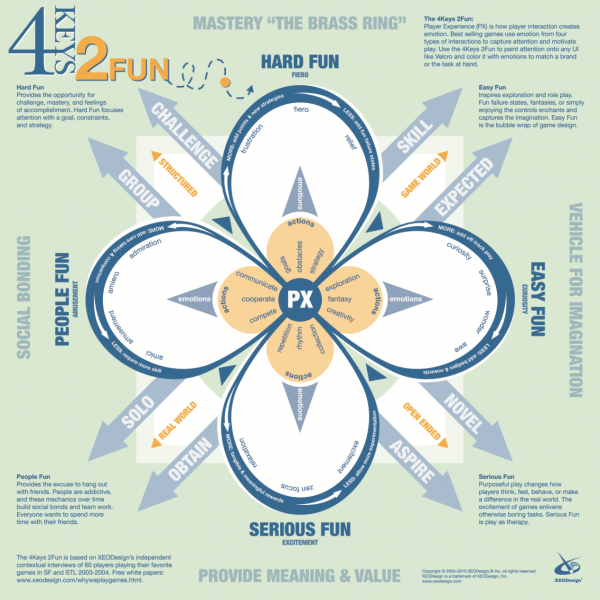Nicole Lazzaro: Difference between revisions
No edit summary |
No edit summary |
||
| (7 intermediate revisions by the same user not shown) | |||
| Line 4: | Line 4: | ||
'''Bio''' | '''Bio''' | ||
Nicole Lazzaro | |||
Nicole Lazzaro pioneered measuring emotions on players faces as they play. In 2004 she developed the "4 Keys to Fun", which she used to design the iPhone's first accelerometer game in 2007, Tilt World. Nicole's work has been widely cited by global news media such as Wired, Fast Company, CNN, CNET, and the Wall Street Journal. She has advised the White House and the US State Department on the use of games to unlock human potential to improve our world. | |||
Accomplishments | Accomplishments | ||
| Line 20: | Line 21: | ||
'''Four keys of fun''' | '''Four keys of fun''' | ||
''As experts in player experiences we see a huge gap between “market research” and what players most enjoy about play. Players may check “good graphics” on a online survey, but our cross-genre contextual research reveals a more interesting story. We know how games deliver more emotions than frustration, excitement, and fear. The secret is in the gameplay. | Quote: ''As experts in player experiences we see a huge gap between “market research” and what players most enjoy about play. Players may check “good graphics” on a online survey, but our cross-genre contextual research reveals a more interesting story. We know how games deliver more emotions than frustration, excitement, and fear. The secret is in the gameplay.'' | ||
''The 4 Fun Keys create games’ four most important emotions'' | |||
''1. Hard Fun: Fiero – in the moment personal triumph over adversity'' | |||
''2. Easy Fun: Curiosity'' | |||
2. Easy Fun: Curiosity | ''3. Serious Fun: Relaxation and excitement'' | ||
3. Serious Fun: Relaxation and excitement | |||
4. People Fun: Amusement | ''4. People Fun: Amusement'' | ||
[[File:4keysoffun.png|600px]]<br /> | [[File:4keysoffun.png|600px]]<br /> | ||
These four main reasons why people play games are how best sellers create more emotions for more captivating play. Each key unlocks a different set of play experiences. Because players alternate between them during a single play session best selling games offer at least three of the 4 Keys 2 Fun. | ''These four main reasons why people play games are how best sellers create more emotions for more captivating play. Each key unlocks a different set of play experiences. Because players alternate between them during a single play session best selling games offer at least three of the 4 Keys 2 Fun.'' | ||
First presented at the Game Developers Conference in 2004; Why We Play Games: 4 Keys to More Emotion shares one slice of what we have learned from our independent cross-genre research on gamers.'' | |||
''The 4 Fun Keys create emotion from interaction in productivity software as well as games. Usability only focuses on minimizing complexity and reducing user frustration. XEODesign’s 4 Keys 2 Fun increase user motivation by harnessing the power of play."'' | |||
The 4 Fun Keys create emotion from interaction in productivity software as well as games. Usability only focuses on minimizing complexity and reducing user frustration. XEODesign’s 4 Keys 2 Fun increase user motivation by harnessing the power of play.'' | |||
Source: http://www.nicolelazzaro.com/the4-keys-to-fun/ | Source: http://www.nicolelazzaro.com/the4-keys-to-fun/ | ||
| Line 43: | Line 46: | ||
'''Links''' | '''Links''' | ||
http://www.xeodesign.com | http://www.xeodesign.com | ||
http://www.nicolelazzaro.com/blog/ | http://www.nicolelazzaro.com/blog/ | ||
Latest revision as of 07:22, 31 October 2018

Nicole Lazzaro is a game researcher, designer, and speaker.
Bio
Nicole Lazzaro pioneered measuring emotions on players faces as they play. In 2004 she developed the "4 Keys to Fun", which she used to design the iPhone's first accelerometer game in 2007, Tilt World. Nicole's work has been widely cited by global news media such as Wired, Fast Company, CNN, CNET, and the Wall Street Journal. She has advised the White House and the US State Department on the use of games to unlock human potential to improve our world.
Accomplishments • Created XEODesign's VR/AR Benchmark Engagement Framework • Discovered the 4 Keys to Fun how games create engagement with emotions (used by 100,000's leading developers world wide) • Designed the first iPhone game (1Million downloads) • Created Tilt World an iOS game to plant 1 million trees in Madagascar (16,000 trees planted so far) • Designed the first body grammar for camera games for a Paul Allen startup 12 years before the Kinect • Track record of game designs that increase engagement and monetization double the industry average
Nicole founded XEODesign in 1992 and studied the success and failure of games across the industry for decades.
Four keys of fun
Quote: As experts in player experiences we see a huge gap between “market research” and what players most enjoy about play. Players may check “good graphics” on a online survey, but our cross-genre contextual research reveals a more interesting story. We know how games deliver more emotions than frustration, excitement, and fear. The secret is in the gameplay.
The 4 Fun Keys create games’ four most important emotions
1. Hard Fun: Fiero – in the moment personal triumph over adversity
2. Easy Fun: Curiosity
3. Serious Fun: Relaxation and excitement
4. People Fun: Amusement
These four main reasons why people play games are how best sellers create more emotions for more captivating play. Each key unlocks a different set of play experiences. Because players alternate between them during a single play session best selling games offer at least three of the 4 Keys 2 Fun.
First presented at the Game Developers Conference in 2004; Why We Play Games: 4 Keys to More Emotion shares one slice of what we have learned from our independent cross-genre research on gamers.
The 4 Fun Keys create emotion from interaction in productivity software as well as games. Usability only focuses on minimizing complexity and reducing user frustration. XEODesign’s 4 Keys 2 Fun increase user motivation by harnessing the power of play."
Source: http://www.nicolelazzaro.com/the4-keys-to-fun/
Links
